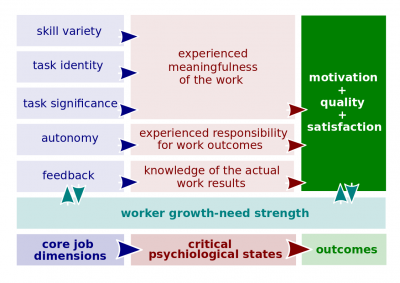Difference between revisions of "Job Characteristics Model"
(→Components) |
MariamKhalid (talk | contribs) |
||
| (3 intermediate revisions by one other user not shown) | |||
| Line 1: | Line 1: | ||
| − | [[File:Job-characteristics.png|400px|thumb|right|[[Job | + | [[File:Job-characteristics.png|400px|thumb|right|[[Job Characteristics Model]]]][[Job Characteristics Model]] (alternatively spelled, the [[job characteristic model]] or [[job characteristics model]]; hereinafter, the ''Model'') is the framework for analyzing and designing jobs that identifies five [[core job dimension]]s, their interrelationships, and their impact on outcomes. These [[core job dimension]]s include [[skill variety]], [[task identity]], [[task significance]], [[autonomy]], and [[feedback]]. |
==Definitions== | ==Definitions== | ||
According to [[Organizational Behavior by Robbins and Judge (17th edition)]], | According to [[Organizational Behavior by Robbins and Judge (17th edition)]], | ||
:[[Job characteristics model]]. A model that proposes that any job can be described in terms of five core job dimensions: skill variety, task identity, task significance, autonomy, and feedback. | :[[Job characteristics model]]. A model that proposes that any job can be described in terms of five core job dimensions: skill variety, task identity, task significance, autonomy, and feedback. | ||
| + | According to [[Management by Robbins and Coulter (14th edition)]], | ||
| + | :[[Job Characteristics Model]]. A framework for analyzing and designing jobs that identifies five primary core job dimensions, their interrelationships, and their impact on outcomes. | ||
==Components== | ==Components== | ||
| Line 10: | Line 12: | ||
==Related lectures== | ==Related lectures== | ||
| − | *[[ | + | *[[Job Dimensions]]. |
*[[Talent Management Quarter]]. | *[[Talent Management Quarter]]. | ||
| − | [[Category: Septem Artes Administrativi]][[Category: | + | [[Category:Management]][[Category: Septem Artes Administrativi]][[Category: CNM Cyber Orientation]][[Category: Articles]] |
Latest revision as of 15:17, 3 June 2020
Job Characteristics Model (alternatively spelled, the job characteristic model or job characteristics model; hereinafter, the Model) is the framework for analyzing and designing jobs that identifies five core job dimensions, their interrelationships, and their impact on outcomes. These core job dimensions include skill variety, task identity, task significance, autonomy, and feedback.
Definitions
According to Organizational Behavior by Robbins and Judge (17th edition),
- Job characteristics model. A model that proposes that any job can be described in terms of five core job dimensions: skill variety, task identity, task significance, autonomy, and feedback.
According to Management by Robbins and Coulter (14th edition),
- Job Characteristics Model. A framework for analyzing and designing jobs that identifies five primary core job dimensions, their interrelationships, and their impact on outcomes.
Components
- Skill variety. The degree to which a job requires a variety of activities so that an employee can use several different skills and talents.
- Autonomy. The degree to which a job provides substantial freedom, independence, and discretion to the individual in scheduling work and determining the procedures to be used in carrying it out.
